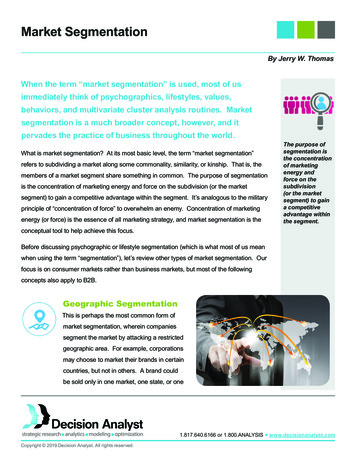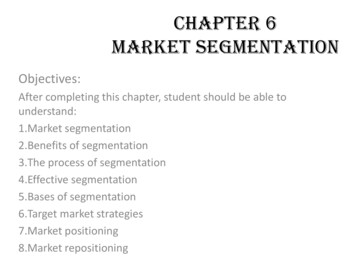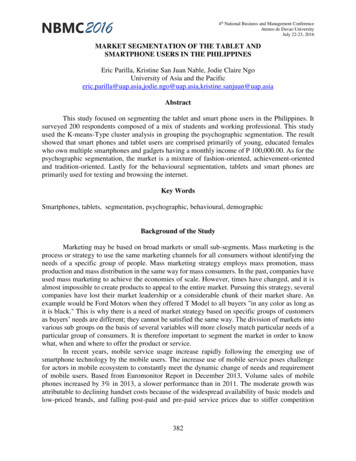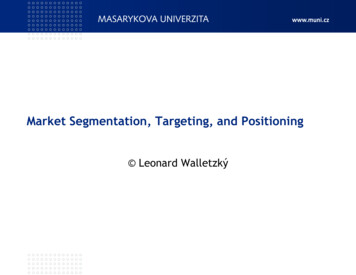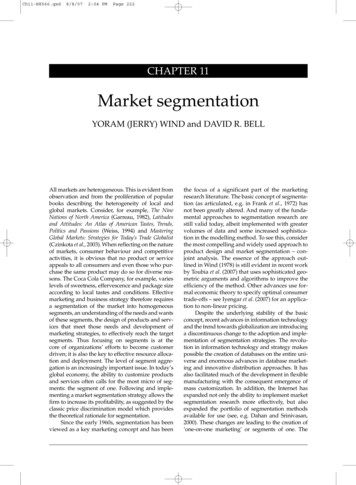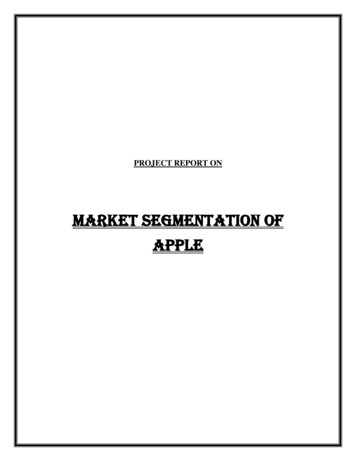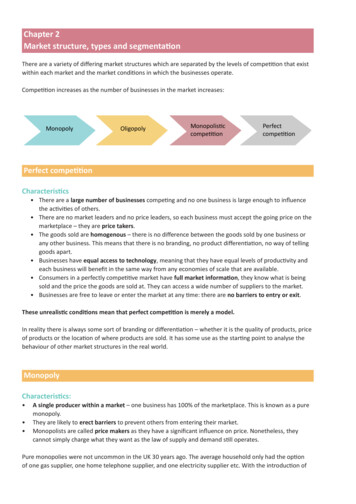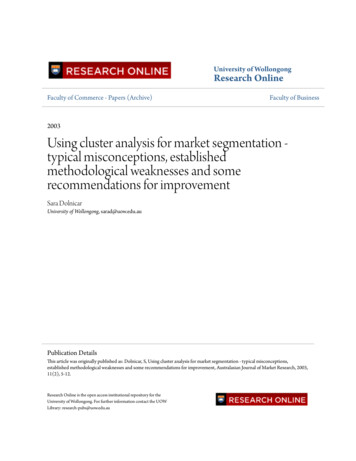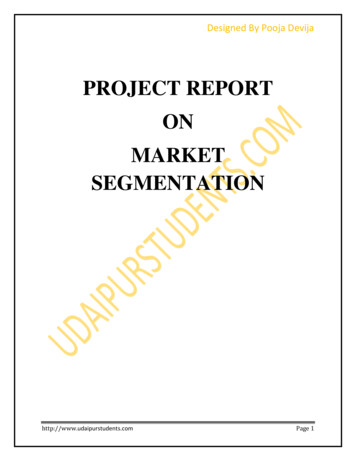
Transcription
Designed By Pooja DevijaPROJECT ts.comPage 1
Designed By Pooja DevijaLIST OF CONTENTSPAGESLTITLENOI.NOINTRODUCTION5-8LITERATURE REVIEW9-15III.RESEARCH Page 2
Designed By Pooja DevijaCHAPTER-1INTRODUCTIONMarket segmentation is the identification of portions of the market that are different from oneanother. Segmentation allows the firm to better satisfy the needs of its potential customers.The marketing concept calls for understanding customers and satisfying their needs better thanthe competition. But different customers have different needs, and it rarely is possible to satisfyall customers by treating them alike.Mass marketing refers to treatment of the market as a homogenous group and offering the samemarketing mix to all customers. Mass marketing allows economies of scale to be realizedthrough mass production, mass distribution, and mass communication. The drawback of massmarketing is that customer needs and preferences differ and the same offering is unlikely to beviewed as optimal by all customers. If firms ignored the differing customer needs, another firmlikely would enter the market with a product that serves a specific group, and the incumbentfirms would lose those customers.Target marketing on the other hand recognizes the diversity of customers and does not try toplease all of them with the same offering. The first step in target marketing is to identify differentmarket segments and their needs.http://www.udaipurstudents.comPage 3
Designed By Pooja DevijaCOMPANY PROFILEAmul was formally registered on December 14, 1946. The brand name Amul, sourcedfrom the sanskrit word Amoolya, means priceless. It was suggested by a quality control expert inAnand. Some cite the origin as an acronym to (Anand Milk Union Limited).The Amul revolution was started as awareness among the farmers. It grew and maturedinto a protest movement that was channeled towards economic prosperity. It is a dairycooperative movement in India. It is a brand name managed by an apex cooperative organisation,Gujarat Co-operative Milk Marketing Federation Ltd. (GCMMF), which today is jointly ownedby some 2.41 million milk producers in Gujarat, India. It is based in Anand town of Gujarat andhas been a sterling example of a co-operative organization's success in the long term. The AmulPattern has established itself as a uniquely appropriate model for rural development. Amul hasspurred the White Revolution of India, which has made India one of the largest milk producers inthe world. It is also the world's biggest vegetarian cheese brand.Amul's product range includes milk powders, milk, butter, ghee, cheese, chocolate, ice cream,cream, shrikhand, paneer, gulabjamuns, basundi, Nutramul brand and others. In January 2006,Amul plans to launch India's first sports drinkStamina, which will be competing with CocaCola's Powerade and PepsiCo's Gatorade.Amul is the largest food brand in India with an annual turnover of US 868 million(2009-2010). Currently Amul has 2.41 million producer members with milk collection averageof 5.08 million litres/day. Besides India, Amul has entered overseas markets such as Mauritius,UAE, USA, Bangladesh, Australia, China, Singapore, Hong Kong and a few South Africancountries. Its bid to enter Japanese market in 1994 had not succeeded, but now it has fresh plansof flooding the Japanese markets. Other potential markets being considered include Sri Lanka.http://www.udaipurstudents.comPage 4
Designed By Pooja DevijaGujarat Cooperative Milk Marketing Federation (GCMMF) is India's largest food productsmarketing organization. It is a state level apex body of milk cooperatives in Gujarat which aimsto provide remunerative returns to the farmers and also serve the interest of consumers byproviding quality products which are good value for money.Members:13 district cooperative milk producers'UnionNo. of Producer Members:2.6 millionNo. of Village Societies:12,792Total Milk handling capacity:10.16 million litres per dayMilk collection (Total - 2006-07):2.38 billion litresMilk collection (Daily Average6.5 million litres2006-07):Milk Drying Capacity:594 Mts. per dayCattle feed manufacturing2640 Mts per dayCapacity:http://www.udaipurstudents.comPage 5
Designed By Pooja DevijaSales TurnoverRs (million)US (in 1050http://www.udaipurstudents.comPage 6
Designed By Pooja DevijaCHAPTER-2LITERATURE REVIEWREQUIREMENTS OF MARKET SEGMENTSIn addition to having different needs, for segments to be practical they should be evaluatedagainst the following criteria: Identifiable: the differentiating attributes of the segments must be measurable so that theycan be identified. Accessible: the segments must be reachable through communication and distributionchannels. Substantial: the segments should be sufficiently large to justify the resources required totarget them. Unique needs: to justify separate offerings, the segments must respond differently to thedifferent marketing mixes. Durable: the segments should be relatively stable to minimize the cost of frequentchanges.http://www.udaipurstudents.comPage 7
Designed By Pooja DevijaMARKET SEGMENTATIONBases for Segmentation in Consumer MarketsConsumer markets can be segmented on the following customer characteristics. Geographic Demographic Psychographic Behavioralistic1. Geographic SegmentationThe following are some examples of geographic variables often used in segmentation.Region: by continent, country, state, or even neighborhoodSize of metropolitan area: segmented according to size of populationPopulation density: often classified as urban, suburban, or ruralClimate: according to weather patterns common to certain geographic regions2. Demographic SegmentationSome demographic segmentation variables include:AgeGenderFamily sizehttp://www.udaipurstudents.comPage 8
Designed By Pooja DevijaFamily lifecycleGeneration: baby-boomers, Generation X, eligionSocial classMany of these variables have standard categories for their values. For example, family lifecycleoften is expressed as bachelor, married with no children (DINKS: Double Income, No Kids),full-nest, empty-nest, or solitary survivor. Some of these categories have several stages, forexample, full-nest I, II, or III depending on the age of the children.3. Psychographic SegmentationPsychographic segmentation groups customers according to their lifestyle. Activities, interests,and opinions (AIO) surveys are one tool for measuring lifestyle. Some psychographic deshttp://www.udaipurstudents.comPage 9
Designed By Pooja DevijaValues4. Behavioralistic SegmentationBehavioral segmentation is based on actual customer behavior toward products. Somebehavioralistic variables include:Benefits soughtUsage rateBrand loyaltyUser status: potential, first-time, regular, etc.Readiness to buyOccasions: holidays and events that stimulate purchasesBehavioral segmentation has the advantage of using variables that are closely related to theproduct itself. It is a fairly direct starting point for market segmentation.Market segmentation is the process in marketing of grouping a market (i.e. customers) intosmaller subgroups. These markets are often termed niche markets or specialty markets. Thesesegments are fairly homogeneous in their attitudes about certain variables. Because of this intragroup similarity, they are likely to respond somewhat similarly to a given marketing strategy.That is, they are likely to have similar feeling and ideas about a marketing mix comprised of agiven product or service, sold at a given price, distributed in a certain way, and promoted in acertain way.The purpose of segmentation is to identify and target prime customer groups (eg the 20% thataccount for 80% of your sales) so that you get the maximum return from a limited marketingbudget (the most bang for your buck).http://www.udaipurstudents.comPage 10
Designed By Pooja DevijaMarket Segmentation Of Amul CHOCO CRUNCHHomogeneity within the segmentHeterogeneity between segmentsSegments are measurable and identifiableSegments are accessible and actionableSegment is large enough to be profitable.These criteria can be summarized by the word SADAM:S Substantial: the segment has to be large and profitable enoughA Accessible: it must be possible to reach it efficientlyD Differential: it must respond differently to a different marketing mixA Actionable: you must have a product for this segmentM Measurable: size and purchasing power can be measured .http://www.udaipurstudents.comPage 11
Designed By Pooja DevijaThe Process-Data Model Of Marketing SegmentationA given diagram is a generic process-data model is given for the whole process ofsegmenting and positioning as a basis of deciding on the most effective marketing strategy andmarketing mix.This model consists of the three main activities: segmenting, targeting and positioning. Itshows the chronological dependency of the different activities. On the right side of the model theconcepts resulting from the activities are showed. The arrows show that one concept results fromone or more previous concepts; the concept cannot be made when the previous activities havenot taken place. Below the three main activities are shortly described as well as their role as abasis for the next step or their dependency on the previous step.http://www.udaipurstudents.comPage 12
Designed By Pooja Devijahttp://www.udaipurstudents.comPage 13
Designed By Pooja DevijaCHAPTER-3RESEARCH METHODOLOGYResearch, particularly in social science contains endless word spinning and too many quotations;end result though may be far from expectations. In context of planning and development it is tobe noted that it significant lies in quality than quantity.Therefore, eventually proper attention has to be paid to designing and adhering to appropriatemethodology throughout so as to improve the quality of the research.Research type:This type of result is Descriptive research .Descriptive Research includes surveys and factfinding enquiries of different kinds. The major purpose of Descriptive Research is description ofthe state of affairs, as it exists at present.Research Design:The survey was conducted for the Amul products where a questionnaire was filled fromthe retailers, wholesaler and consumers. The population and the samples were evenly divided insuch a manner so as to extract the best possible results within the given limitation.Sampling Design:The survey was conducted within a selected part of Pune region by dividing the sampleevenly. The whole of Pune region was divided based on the number of wholesalers and retailers.Sampling Unit: Retail outlets.Sample Size: 950 retail outlets.Areas Covered: NDA, Uttamnagar, Manikbaug, Suncity, Wadgoan, PimpriNighidi,Vallabhnagar, Ajemera, Pradhikiran, Paudroad, Warje 1 & 2, Karvenagar, Kothrud.Method of Data collection:There are several method of data collection available but,one of the most commonmethod is-questionnaire method,same was found appropriate for this research , for the reasonthathttp://www.udaipurstudents.comPage 14
Designed By Pooja DevijaQuestionnaire are one of the most commonly used methods. It is cost-effective.It is time-effective.The questionnaire was designed by us and also with the help of panel members of Amul.Determination of sources of Data collection:A list of retailers were generated area wise and later on contacted individually.Sampling procedures: The procedure employed for conducting the survey is on random basis. The database was referred for carrying out the survey. First the areas to be covered weredecided and then the respondents were contacted directly. As the respondents filled the sheets, his/her view relating to his expectation was alsonoted. This was done with the aim to gather the information, which would provide relatedand relevant insights as to what did the customer expect.Tools for the Data Collection:For the collection of primary data one to one interview method with the help of well structuredquestionnaire with both open and closed ended questions were used.The survey of all retailerswas conducted and their responses were taken down carefully with the help questionnaire.Tools for Data Analysis:For the purpose of analyzing the data statistical tools such as weighted average methodand percentage analysis were used.For better understanding the raw data tools like bar graphsand pie charts were used.Limitations:The sample size: The biggest limitation of the research is the wide area of Pune region. Only30% of the entire area was considered for the research.1. The sample size was too small when we take the universe into the consideration, which isvery big.2. The survey was done in a part of Pune city hence if generalizations are to be made forwhole city, some deviations might occur.http://www.udaipurstudents.comPage 15
Designed By Pooja Devija3. Though the data is collected in a best possible way but still the above figures depict theperformance of the company.4. The sample selected wasdone on random basis and taken from few selected areas that aresupposed to represent the whole population. Hence some deviations might be there whenthe same is applied to the whole universe.5. Retailers did not provide the real data for the study.6. Retailers are scattered all over Pune city and its very difficult to locate and contact eachof them.7. The big retailer are not ready to fill up the questionnaire.8. Feedback may not be very reliable owing to difference in opinion.Research Desig
Market segmentation is the identification of portions of the market that are different from one another. Segmentation allows the firm to better satisfy the needs of its potential customers. The marketing concept calls for understanding customers and satisfying their needs better than the competition. But different customers have different needs, and it rarely is possible to satisfy all .

